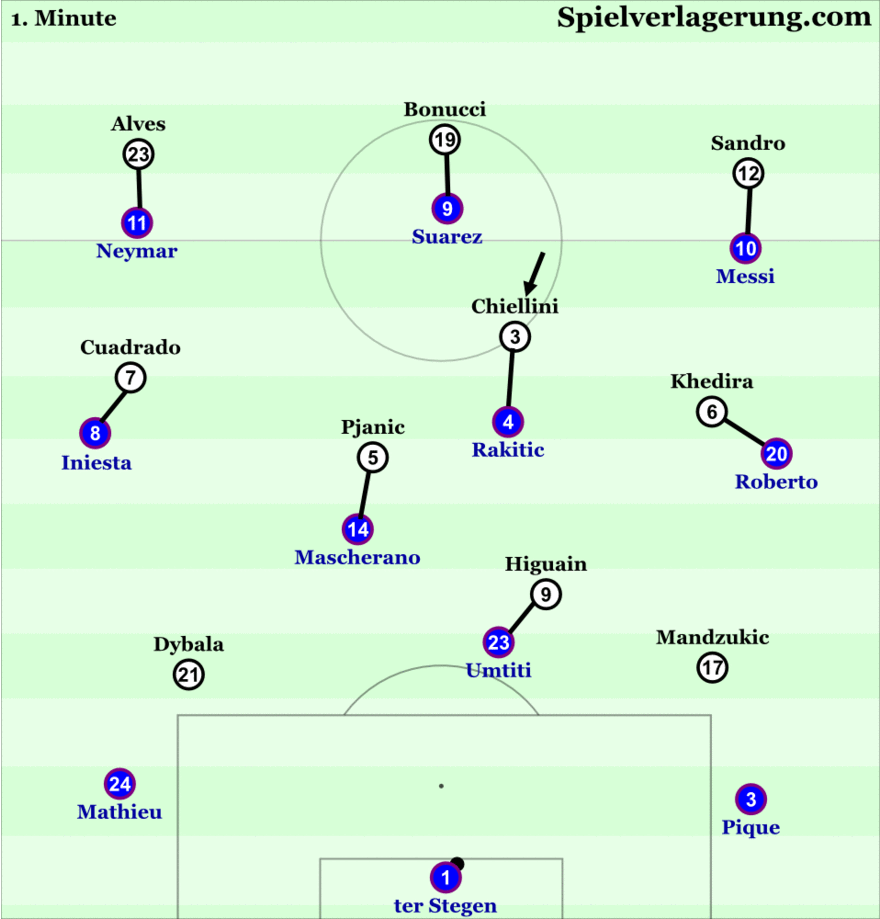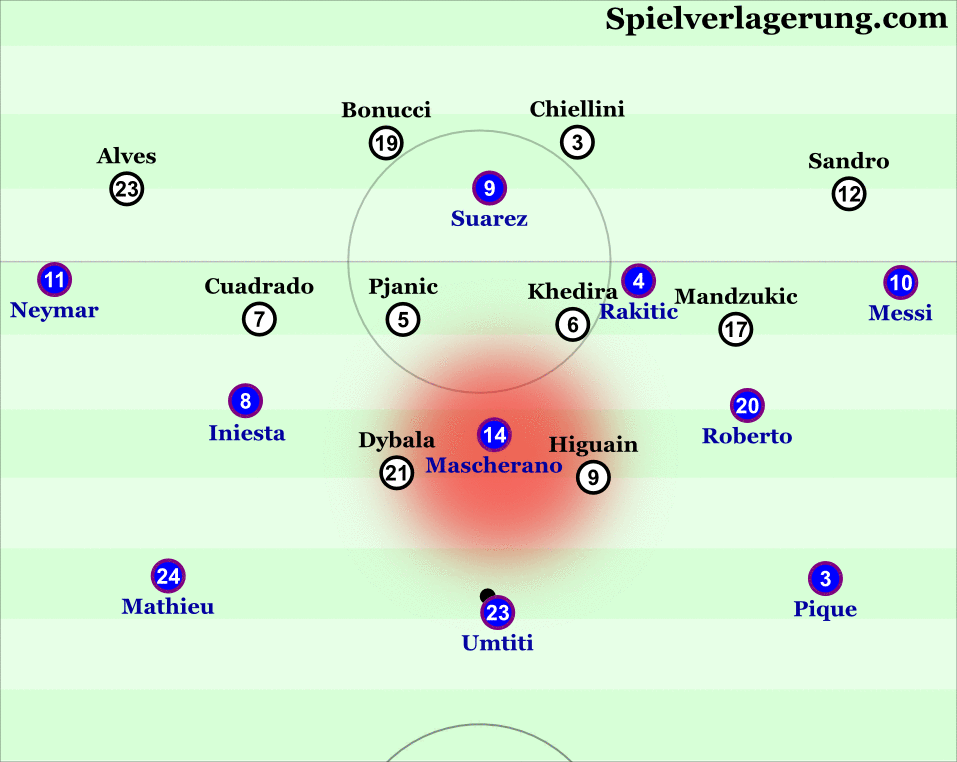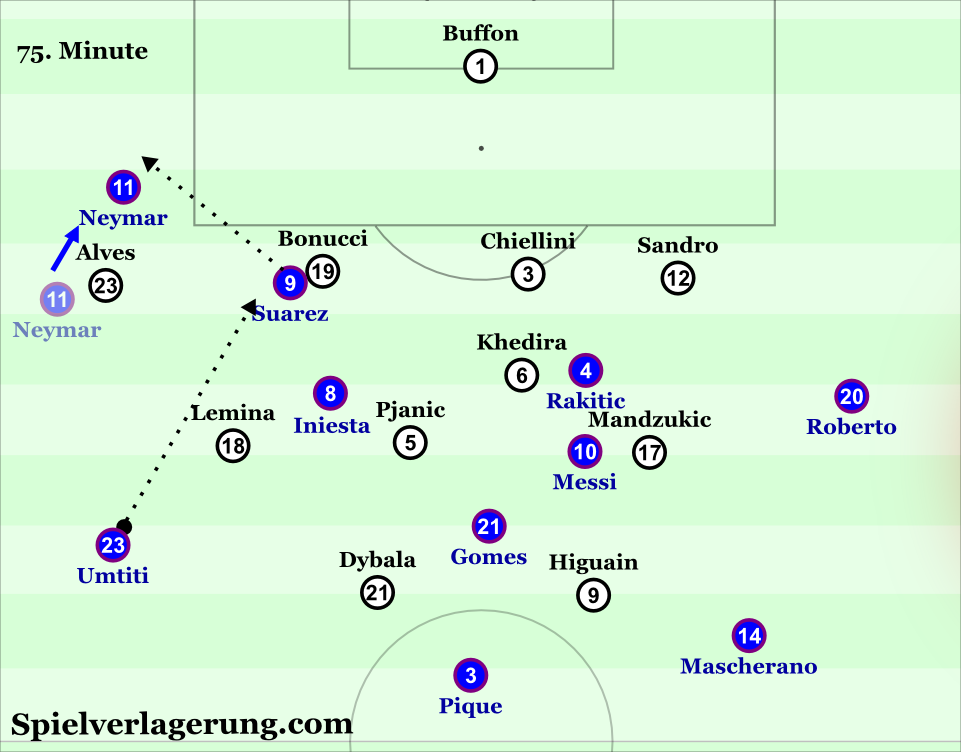1st Leg: Juve take commanding lead in Turin
Juventus and Barcelona were drawn in the quarter-final of the Champions League. The tie pitched the 2015 finalists together, giving the Italian side the chance for revenge. The Spanish champions came into the tie on the back of the miracle comeback against PSG whilst Juventus coasted past Porto. Juventus’ outstanding defensive structure would clash against Barcelona’s world class attackers, an exciting tie lay ahead.
Juve’s man-oriented pressing
Early in the game Juventus pressed high against Barcelona’s build-up, preventing the away side from finding a stable start to the game. An important part of their pressing was forcing Barcelona backwards to ter Stegen and forcing them long from there.
From Barcelona’s goal kicks, Mandzukic and Dybala would stand at the edges of the box with Higuain in the D giving them quick access to Barcelona’s back 3. Interestingly however, they would allow the first pass to Pique or Mathieu (side backs) before beginning to press them. By timing their pressing Mandzukic or Dybala could arrive as soon as Pique or Mathieu received, allowing them to block a wide range of angles the ball and forcing an immediate back pass to the goalkeeper. From here they would press the German shot-stopper diagonally, blocking the return pass with their cover shadow. With Higuain blocking Umtiti in the centre and the ball-far forward moving up towards the far side back, ter Stegen was forced to look towards the 2nd or 3rd lines of Barcelona’s shape.
The distance to the Messi, Neymar and Suarez would require a long ball which Juventus’ defenders would be favourites to win with their physical superiority. In midfield, Mascherano, Roberto, Iniesta and Rakitic were marked tightly. The pressure on ter Stegen was vital in reducing the time for Barcelona’s midfielders to get free from their markers, and forcing the keeper into hopeful long balls.
Whilst their physical superiority allowed them to win the first balls, they lacked the same level of control of 2nd balls. Barcelona at times had free men in these situations when Juventus committed two players to press ter Stegen, or two defenders to contest an aerial duel. However, these situations were not particularly dangerous since Barcelona had to commit several players to deep and wide positions in their attempts to build-up.
Similar principles were in effect in open play where their pressing was based on preventing progress on the ball side, and arriving early to press on the far side after switches to force Barcelona backwards gradually. Dybala and Higuain in the centre worked to cover Mascherano forcing the ball wider to the side backs. From there, the ball-near forward would focus on blocking the back pass to Umtiti in the centre, whilst the ball-far forward would drop and cover Barcelona’s holding midfielder.
Naturally the next route for Barcelona was to look towards the flanks, however, Alves and Sandro were aggressive in pushing up on their flanks to press Neymar or Messi turning and dribbling towards goal. They would be supported by the closest winger who was responsible for blocking passes on the inside. Neymar/Messi would then be forced to dribble backwards and look to re-circulate. When Barca switched to the other flank, Juventus’ full-back would advance quickly to force the ball backwards.
As Barcelona were gradually forced backwards, Juventus would move from their 4-4-2 midfield pressing to a 4-3-3 in high pressing, dictated by their man-oriented focus. By forcing the ball all the way back to ter Stegen and marking his passing options they could force Barcelona into long balls.
Deeper defending & Winger-Full back relationships
When Juventus were forced back to defend in deeper positions there were a number of aspects within their 4-4-2 shape that stood out. One of these was the defensive relationship between the wingers and the full-backs. With Messi and Neymar starting high and wide on either flank, Sandro and Alves were positioned wide, creating a wide back line. This created open channels to the centre backs, which the wingers were responsible for covering creating a narrow midfield line.
In most teams the full-backs start off in narrow positions to protect the space between them and the centre backs. One problem with this however is that if they do not move wide early enough, the opponents’ winger can create a dynamic advantage, dribbling forwards as the full-back comes out towards them. With the full-backs positioned wide, Juventus had immediate access to Barcelona’s wingers. By maintaining small distances to the diminutive wingers, Alves and Sandro could avoid the dynamic disadvantage and could force them backwards by virtue of pressing as soon as the Barcelona winger received the ball.
The wingers would protect the full back-centre back channel with their cover shadow, allowing them to block the quickest way to exploit the space. This meant that if Barcelona were to access this space it would have to be with lofted passes, which would give Bonucci or Chiellini time to shift across. The positioning of the wingers also had benefits for counter attacks. Since they defended in narrow positions, they were better connected to their team-mates and more accessible for switches to the far side.
Another outstanding aspect was how the home side reacted to passes within their shape. If Barcelona managed to access the space behind Juventus’ midfield line, the nearest centre back would push forwards aggressively. Whilst this is quite natural and used to prevent opponents from turning towards goal, Juventus’ defenders were also particularly intent on winning the ball in these situations. This was paired with intense backwards pressing from Khedira and Pjanic creating enough compactness and intensity to force the likes of Messi(!) into losing the ball.
Barca’s offensive issues
Barcelona displayed a number of issues in attack that played a large role in their failure to score. One of these issues was an inefficient use of the vulnerable space in Juventus’ 4-4-2 shape. In a 4-4-2 defence, when the two strikers are focused on blocking the centre, the space besides them can be difficult for the defensive team to control.
Within the back 3, Pique and Mathieu were in strong positions to exploit this space by dribbling forwards. Doing so would draw a Juventus midfielder out of position, freeing spaces deeper within the defensive structure. Perhaps due to a fear of being trapped, the Barcelona side backs failed to take advantage of these situations. They were often too reserved, advancing with the ball slightly, before looking to re-circulate possession if they couldn’t progress on the near side.
The biggest contributing factor to their offensive struggles, however, was a lack of well timed runs in behind the Juventus defence. This was where the Spanish side missed Alba and his far side depth runs which allow them to break through into the box. The lack of runners into depth had a number of negative effects on the game for Lucho’s side. Without the threat of runners, Juventus’ defensive line were constantly able to defend on the front foot aggressively.
This led to greater compactness from the home side, with Bonucci and Chiellini able to close the space in front of them. Furthermore, it allowed Allegri’s men to put greater pressure on dribbles from the likes of Messi and Neymar, since the likes of Sandro could press forward with little risk of Barcelona players attacking the space they left behind.
Juventus attacks and cut backs
Juventus’ attacks were largely based on creating good conditions for Cuadrado on the right flank. As such, several of their attacks
started on the left side with Mandzukic receiving as a target and resisting pressure with his physical superiority. As Barcelona shifted across, Mandzukic would hold onto the ball for as long as possible before laying it off to Khedira or Pjanic. By holding onto the ball, the Croatian forward could attract the Barcelon who would have sufficient time to switch the play to Cuadrado.
In these situations Barcelona lacked proper access on the near side to direct Juventus wider on the left wing or back into deeper positions. This was an issue when combined with their narrow shape and defensive line, meaning Cuadrado could receive in large space and force the nearest Barcelona defender backwards by dribbling at him, eventually allowing him to reach dangerous spaces.
When Juventus progressed on the wings Barcelona had issues in covering the edge of the box and protecting against cut backs. In transitional situations, the space was created by the defenders dropping to anticipate a cross and the midfielders being slow to drop back. In settled defending situations the space on the edge of the box was often left free since the midfielders dropped back early on top of the defence, potentially to deal with the physical presence Juventus boasted in attack.
However, this meant the Turin side could create dangerous situations even without committing several players to the attacks. This was evident in the 2nd goal, where Dybala was able to score despite Juventus being outnumbered 7v3 in the surrounding area.
2nd half developments
In the 2nd half Barcelona made better and more consistent attempts to attack the space behind Juventus’ defence with runners. With the channels between Juventus’ full-backs and centre-backs being quite large, many of Barcelona’s attacks were focused on exploiting this space.
Luis Suarez was a big part of this with his wide movements towards either flank. The Uruguayan focused on using his body to “pin” the nearest centre back. At times he was able to receive a through ball, roll the nearest opponent and advance for a shot on goal. On other occasions he would hold off Chiellini/Bonucci, and wait for the ball-near Barcelona winger to make a run before releasing them with through balls.
Sergi Roberto was also integral, and attacked the channel between Sandro and Chiellini consistently, providing either an outlet in reaction to Messi’s dribbles or preventing the opponents from pressing Messi aggressively in these situations. On a couple of occasions the Spaniard was able to receive through balls in this space to attack the box when Mandzukic and Sandro failed organise their covering responsibilities quickly enough.
Late on in the game Allegri brought on Barzagli as Juventus moved into a 5-4-1 defensive shape. With a 5 man backline, the full-backs could defend wide like previously, and the side backs could protect the channels that Barcelona were running through. This made it far tougher for Barcelona to break through, and assisted with the Italian side seeing out the game.
Midway Conclusion
The result left Barcelona needing yet another miracle, this time they would need 4 goals against a side who have only conceded 2 in the whole competition to date. The lack of depth in attack was a big factor in their inability to penetrate Juventus’ defence. However, they did manage to create some of the game’s best chances and were somewhat unlucky not to score at least once.
For Juventus this was a perfect result, owing a lot to their work without the ball. The defensive strategy was well executed and the roles of the full-backs was fitting in the context of the opponents. A slight issue was how long it took Allegri to react to Barcelona attacking the full back-centre back channels, but fortunately for the Italians, Barcelona were unable to capitalise on the resulting chances.






1 Kommentar Alle anzeigen
DF May 8, 2017 um 11:14 am
Great Analysis JD; as usual! Keep up the good work.
As a regular reader of your analytical pieces on this platform, I request you to write a piece on the 1st leg match between Monaco and Juventus at STADE LOUIS ||. I think it would be fascinating to know how Juventus managed to stop this Monaco side who have been scoring for fun this season in all competitions.
Hopefully you will keep my request this time around. Take care; Bye!